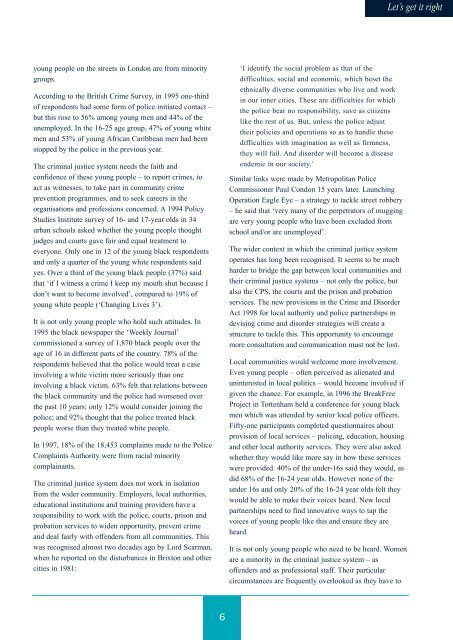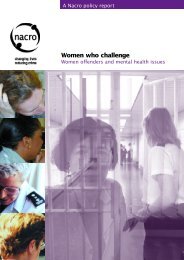Let's get it right: race and justice 2000 - Nacro
Let's get it right: race and justice 2000 - Nacro
Let's get it right: race and justice 2000 - Nacro
- No tags were found...
You also want an ePaper? Increase the reach of your titles
YUMPU automatically turns print PDFs into web optimized ePapers that Google loves.
Let’s <strong>get</strong> <strong>it</strong> <strong>right</strong>young people on the streets in London are from minor<strong>it</strong>ygroups.According to the Br<strong>it</strong>ish Crime Survey, in 1995 one-thirdof respondents had some form of police in<strong>it</strong>iated contact –but this rose to 56% among young men <strong>and</strong> 44% of theunemployed. In the 16-25 age group, 47% of young wh<strong>it</strong>emen <strong>and</strong> 53% of young African Caribbean men had beenstopped by the police in the previous year.The criminal <strong>justice</strong> system needs the fa<strong>it</strong>h <strong>and</strong>confidence of these young people – to report crimes, toact as w<strong>it</strong>nesses, to take part in commun<strong>it</strong>y crimeprevention programmes, <strong>and</strong> to seek careers in theorganisations <strong>and</strong> professions concerned. A 1994 PolicyStudies Inst<strong>it</strong>ute survey of 16- <strong>and</strong> 17-year olds in 34urban schools asked whether the young people thoughtjudges <strong>and</strong> courts gave fair <strong>and</strong> equal treatment toeveryone. Only one in 12 of the young black respondents<strong>and</strong> only a quarter of the young wh<strong>it</strong>e respondents saidyes. Over a third of the young black people (37%) saidthat ‘if I w<strong>it</strong>ness a crime I keep my mouth shut because Idon’t want to become involved’, compared to 19% ofyoung wh<strong>it</strong>e people (‘Changing Lives 3’).It is not only young people who hold such att<strong>it</strong>udes. In1995 the black newspaper the ‘Weekly Journal’commissioned a survey of 1,870 black people over theage of 16 in different parts of the country. 78% of therespondents believed that the police would treat a caseinvolving a wh<strong>it</strong>e victim more seriously than oneinvolving a black victim. 63% felt that relations betweenthe black commun<strong>it</strong>y <strong>and</strong> the police had worsened overthe past 10 years; only 12% would consider joining thepolice; <strong>and</strong> 92% thought that the police treated blackpeople worse than they treated wh<strong>it</strong>e people.In 1997, 18% of the 18,453 complaints made to the PoliceComplaints Author<strong>it</strong>y were from racial minor<strong>it</strong>ycomplainants.The criminal <strong>justice</strong> system does not work in isolationfrom the wider commun<strong>it</strong>y. Employers, local author<strong>it</strong>ies,educational inst<strong>it</strong>utions <strong>and</strong> training providers have aresponsibil<strong>it</strong>y to work w<strong>it</strong>h the police, courts, prison <strong>and</strong>probation services to widen opportun<strong>it</strong>y, prevent crime<strong>and</strong> deal fairly w<strong>it</strong>h offenders from all commun<strong>it</strong>ies. Thiswas recognised almost two decades ago by Lord Scarman,when he reported on the disturbances in Brixton <strong>and</strong> otherc<strong>it</strong>ies in 1981:‘I identify the social problem as that of thedifficulties, social <strong>and</strong> economic, which beset theethnically diverse commun<strong>it</strong>ies who live <strong>and</strong> workin our inner c<strong>it</strong>ies. These are difficulties for whichthe police bear no responsibil<strong>it</strong>y, save as c<strong>it</strong>izenslike the rest of us. But, unless the police adjusttheir policies <strong>and</strong> operations so as to h<strong>and</strong>le thesedifficulties w<strong>it</strong>h imagination as well as firmness,they will fail. And disorder will become a diseaseendemic in our society.’Similar links were made by Metropol<strong>it</strong>an PoliceCommissioner Paul Condon 15 years later. LaunchingOperation Eagle Eye – a strategy to tackle street robbery– he said that ‘very many of the perpetrators of muggingare very young people who have been excluded fromschool <strong>and</strong>/or are unemployed’.The wider context in which the criminal <strong>justice</strong> systemoperates has long been recognised. It seems to be muchharder to bridge the gap between local commun<strong>it</strong>ies <strong>and</strong>their criminal <strong>justice</strong> systems – not only the police, butalso the CPS, the courts <strong>and</strong> the prison <strong>and</strong> probationservices. The new provisions in the Crime <strong>and</strong> DisorderAct 1998 for local author<strong>it</strong>y <strong>and</strong> police partnerships indevising crime <strong>and</strong> disorder strategies will create astructure to tackle this. This opportun<strong>it</strong>y to encouragemore consultation <strong>and</strong> communication must not be lost.Local commun<strong>it</strong>ies would welcome more involvement.Even young people – often perceived as alienated <strong>and</strong>uninterested in local pol<strong>it</strong>ics – would become involved ifgiven the chance. For example, in 1996 the BreakFreeProject in Tottenham held a conference for young blackmen which was attended by senior local police officers.Fifty-one participants completed questionnaires aboutprovision of local services – policing, education, housing<strong>and</strong> other local author<strong>it</strong>y services. They were also askedwhether they would like more say in how these serviceswere provided. 40% of the under-16s said they would, asdid 68% of the 16-24 year olds. However none of theunder 16s <strong>and</strong> only 20% of the 16-24 year olds felt theywould be able to make their voices heard. New localpartnerships need to find innovative ways to tap thevoices of young people like this <strong>and</strong> ensure they areheard.It is not only young people who need to be heard. Womenare a minor<strong>it</strong>y in the criminal <strong>justice</strong> system – asoffenders <strong>and</strong> as professional staff. Their particularcircumstances are frequently overlooked as they have to6

















